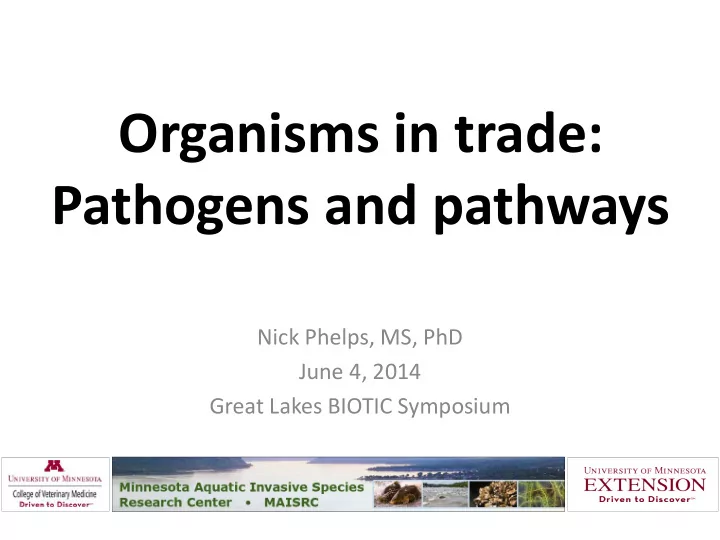

Organisms in trade: Pathogens and pathways Nick Phelps, MS, PhD June 4, 2014 Great Lakes BIOTIC Symposium
Can pathogens be spread by organisms in trade?
We know there are pathogens Live specimen release Live baitfish Aquarium trade Aquaculture
We know there are pathways Wild spottail shiner network for two harvesters What if they were infected with VHSV??
Risk factors for the introduction of VHSV in the Great Lakes region VHSV Expert Panel. 2010. Veterinary Preventative Medicine 94:128-139.
Examples of (potential) pathogen spread via organisms in trade 1. Concern in Great Lakes region 2. Easily transmissible 3. Probable past and/or future trade pathway
Aquarium Trade Koi Herpes Virus – Highly lethal virus to naïve koi/common carp – Intentionally infected-recovered to make ‘immune’ • Primarily done in Israel, sold around world • Survivors can shed virus! – Spread to many koi farms, ponds, and wild Largemouth Bass Virus – Major disease of LMB in SE USA • Recent mortality event of other Centrarchid species – Likely introduced via aquarium fish in Florida
Aquarium Trade Bangaii Cardinalfish iridovirus – Repeated 100% mortality of purchased fish – Likely post-collection transmission at export center • High stress, multiple species Sturgeon herpes virus-3 – Major lesions and eventual death in Lake Sturgeon – Recent introductions of smaller LS – Source unknown
Baitfish Trade Ovipleistophora ovariae – Sterilizes golden shiners – First found in AR in 1960s Novel viruses – UW-La Crosse survey and MN VDL – 10+ new viruses (and counting…) – Largely unregulated
Frozen Baitfish Trade Viral hemorrhagic septicemia – Most serious disease of freshwater fish in USA • First identified in Great Lakes in 2003 • Limited to wild fish in Great Lakes region – Source unknown • Frozen baitfish? • Ballast water? – Life fish and fomite transfer is high risk – Current management: Limit spread
Aquaculture Trade White sucker bunyavirus – Routinely found in several apparently healthy white sucker populations – Transmissible to muskellunge, high mortality Fathead minnow picornavirus – First isolated: IL, Now: MN, MT, WI • Fathead minnow and brassy minnow – Farm and wild populations positive – No clinical disease? – Transmissible to walleye, no known disease
Aquaculture Trade Heterosporis spp. – Intracellular muscle parasite – First identified in MN and WI in 2000 – Introduced via aquarium trade? – Potential transmission via walleye or baitfish Invasive carp – ??? – Baseline health to be established – Send me sick carp!
Fsh
Not convinced? • Undiagnosed fish kills – 350+ reported in MN from 2003-2013 • Estimated 10% reported – Can not rule out potential invasive pathogens • Will all pathogens cause problems? – No, don’t panic! – NEED risk assessment specifically for pathogens
What can we do about it? Emerging disease = Invasive species
Control Options • Establish risk tolerance • Involve all stakeholders – Essential for pathway intervention • Maintain status quo – How effective has it been? – Consider long-term collateral damage from pathogens
Control Options • Regulatory intervention – Selective trade restrictions • VHS – USDA-APHIS, swift and severe trade restrictions in 2006 – No consensus on Final Rule, removed from list in 2014 – Plethora of state regulations now in place – Complete prohibition • Baitfish – Minnesota and Maine: No import – Michigan: No export
Interrupt Pathway • Testing, testing, testing – Pre-VHS, testing limited to salmonids – Post-VHS: All susceptible species must be inspected when moving between state lines • Intrastate testing for additional assurance • Slow, labor intensive, expensive – Targeted surveillance testing • Establish baseline – Challenge: What and how to test?? • Visual exam, report and/or cull
Risk factors for the introduction of VHSV in the Great Lakes region VHSV Expert Panel. 2010. Veterinary Preventative Medicine 94:128-139.
Interrupt Pathway • AIS-HACCP • Good aquaculture practices • Aquaculture – Increase local, healthy options – Must be cost effective – Must have regulatory support
Interrupt Pathway • Public education/outreach – Integrate disease into AIS efforts • Pathways are similar – why not? • Powerful message! R. Getchell P. Bowser E. Cornwell
Interrupt Pathway • Explicit integration of risk assessment – Identify and prioritize new and existing threats? – What can be done to mitigate risk? • Proactive research – Surveillance – Infection trials – Modeling
Take home messages • Pathogens are (and have been) moving with invasive organisms in trade • Will continue to spread without pathway disruption – Opportunities for intervention exist • We don’t know what is next, be prepared
Questions? phelp083@umn.edu
Recommend
More recommend